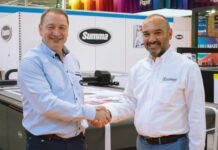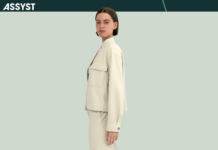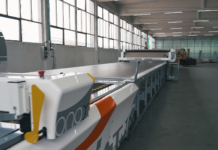by Paola Tisi
From labelling to packaging, to special coordinated image projects, Brand Identity and Brand Protection projects: we visited Varcotex, where Made in Italy solutions and products offer a cutting edge technology and style, developed and implemented for top Italian and international fashion system brands
Varcotex, established in Carpi in 1982 and Europe’s only company fully in control of its production, not only supplies woven labels, hangtags for fashion, printed labels, leather and high frequency labels. It also acts as a partner to develop technological and aesthetic solutions with high added value for big international fashion brands, such as Kering Group, Dolce&Gabbana, Aeffe, Dior, Moncler, Moschino, Max Mara, Ferragamo, Bulgari.
Lead by Paolo Munari, the company, focused over time on proximity and ethics of Italian professionals, closed 2021 with a significant increase of its turnover compared to both 2020 and 2019.
Varcotex is a vertically integrated company with over 90% of its sales in Italy creating an understanding among stakeholders and customers on the importance of a full control of the supply chain, to avoid transition issues and subcontracting not always duly traceable and tracked.
A Partner of Evolving Technology and Style
Varcotex, a valuable partner for Fashion and Luxury firms, is a vertically integrated company that makes everything in house, fully in control of each single step of the manufacturing process and of each single product.
In addition, different sections of the company – from weaving and leather processing to lithographic, screen an digital printing – obtain a full product integration and offer customers perfectly finished products – from graphics to material shaping – traced and traceable, resulting from combined skills that only a Made in Italy manufacturing process can offer.
They develop and customize products to meet a customer’s requirements, even suggesting solutions, both drawing from a set of innovating style and material samples and exploiting suitable skills to develop ad hoc technological solutions.
An example: for a famous maison, Varcotex developed and manufactured woven labels for sneakers, meeting a specific aesthetic and technological requirement: by means of a printer, the printing section prepared an overprint on fabric to obtain a vintage effect that could not be achieved on a loom. The laser machine section introduced an invisible RFID system into the label, to ensure traceability and security.
«We developed these machines in house to be able to embed the RFID into labels», Mr Munari explains. «No such performing laser machine was available on the market to hit our target; consequently, we built them adapting the existing ones». He adds, while showing a fabric roll, «Here are some woven QR Codes, millions of them, however all different, made for Texas police uniforms and to detect false items. Washing is not a problem, as these are woven, not printed codes. For us to reach this target we had to carry out a lot of research, hard work and a big investment».
All in all, the company meets the brand protection requirement with RFID embedded into hang tags and washable woven labels, NFC in hang tags and woven labels, holograms, a micro-written thread introduced in fabrics and woven labels, tracers that customized instruments can detect, labels with woven numerical, alphanumerical codes, unique QR Codes with web application check, invisible inks.
Product Classes
The Weaving department, with 50 needle, rapier and air jet looms, weaves selvaged, ultra-cut, tubular labels, woven tapes, bags, fabrics and linings for leather goods, composition and care labels.
Our Finishing department can convert all textile products in various trimmings, thanks to bonding, orthogonal cutting using a cutter, blank cutting, laser cutting, perforations, threading and gluing.
The Printing department makes hang tags, printed labels and tapes, back pocket labels, booklets, size labels and pouches. They print brochures, header cards, flyers, folders, business cards and packaging.
Printing jobs are carried out on 30 machines to block or series print paper, plastics, textiles, synthetics and leather with different techniques. They use plant- and water-based inks.
Denim Hub is the creative laboratory for leather, imitation leather, synthetics, jacron, microfiber; techniques applied are hot stamping, high frequency and screen-printing. Leather is manually crafted with procedures such as waxing, polishing, swabbing, laser etching to obtain number of effects.
The high frequency electromagnetic field used in a dedicated area shapes soft high and low relief details thanks to thermoforming. Materials used are PU, nylon, imitation leather and leather, natural or synthetic fabrics.
Finally, the Packaging department designs and makes paper, textile and non-woven, PET bags, cardboard boxes and plastic packaging.
«All what we make – Mr Munari states – is based on graphic design and planning with approximately fifteen professionals and a lot of research, a major target that allowed us to be not just manufacturers, but proactive partners with specific skills also as regards fashion trends and innovative materials».
Research and Sustainability
Research, a basic factor at Varcotex, goes hand in hand with sustainability, matched by ethics, transparency and a short supply chain, unavoidable in today’s manufacture, according to Paolo Munari.
The company designed its firm path towards sustainability with the “Zero Km – Close to you” campaign, with its new sustainable range Heartearth and some projects of Corporate Social Responsibility. Recently, it also took new measures to cut its impact on the environment: weaving machines are being replaced with latest generation machinery, that are 30% quieter and feature 20% less energy consumption; 100% electric vehicles, photovoltaic power stations; the Varcobosco, a forest in the Carpi area to plant trees and fight against CO2 emission in the atmosphere. Here are some certifications: UNI EN ISO 9001; GRS; Oeko-Tex Standard 100 class 1; FSC and the latest, UNI EN ISO 14001 on environmental management.
«Companies not involved in manufacturing, slimmer as they do not have all steps in house, e.g. weaving, lithography, screen-printing or flexographic printing – Mr Munari adds – though showing an ISO 14001 certification, do not really protect their customers and the environment. In fact, they risk introducing in the supply chain suppliers who do not comply with sustainability criteria, which we intend to comply with constantly, especially in countries where assessing the environment protection regulations is a difficult task».
Greener and Greener Materials
As regards the selection of materials, after Biolabel – a woven label made of 100% natural and organic raw materials – the company carries on its engagement for a green planet. They study and offer new materials, e.g. for the A/W 22/23 collection: from nettle, flax, pulp, organic cotton, paper yarns to imitation leather from apples, maize, pineapple leaves; walnut wood essential oils, cork, to recycled polyester and polyamide, recycled and organic plastics.
Green paper is a new wide-open field including ecological and recycled paper from waste paper as well as upcycling paper from recovered materials: from citrus fruits, grapes, cherries, lavender, maize, olives, coffee, kiwi, hazelnuts and almonds, that bestow the finished product an unusual, sophisticated look and touch. To replace cellulose, leather processing and leather goods waste are used to make leather paper for luxury packaging and labelling.
«The design department is on the front line looking for new materials, ethical supports and cutting edge solutions in a constantly updating process», Mr Munari adds. «Every 6 months we develop new ranges and present them to our customers starting from our mood board, defining them to meet their demand in a continuous interchange».
He concludes adding: «We invested and are still investing a lot in house. We are so deeply rooted in the area that one can “see inside” and notice the green soul gaining more and more space within Varcotex in our vision, philosophy and approach».
DIDA
0 apertura: 4 foto
1
Paolo Munari, CEO, Varcotex
2
With over 100 processing machines operating in different departments, Varcotex manufactures every day 1,300,000 woven labels, 1,100,000 hang tags and 1,000,000 printed labels
3
In the Weaving department there are 50 needle, rapier and air jet looms
4
An RFID system inserted into each label to ensure traceability and security
5
Woven QR Codes with unique codes
6
The “Concreto” label is made of recycled paper, including 40% used cotton fibres and 15% cotton processing waste
7
A pineapple leaf label from the “Heartearth” range



